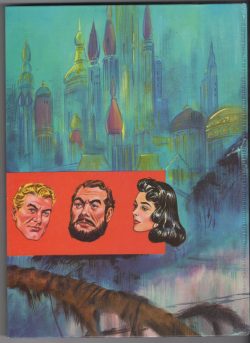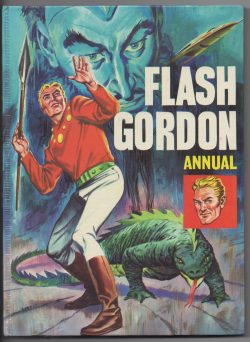

By anonymous staff of the Mick Anglo Studio, Dick Wood, Al Williamson, Don Heck & various (World Distributor’s [Manchester] Ltd.)
No ISBN – ASIN B000ZOP1GY
By most lights, Flash Gordon is the most influential comic strip in the world. When the hero debuted on Sunday January 7th 1934 (with the superb but rather dated Jungle Jim running as a supplementary “topper”) as response to revolutionary, inspirational, but clunky Buck Rogers (by Philip Nolan & Dick Calkins and which had also began on January 7th but in 1929), a new element was added to the realm of fantasy wonderment: Classical Lyricism.
Where Rogers had traditional adventures and high science concepts, this new feature reinterpreted Fairy Tales, Heroic Epics and Mythology. It did so by spectacularly draping them in the trappings of the contemporary future, with varying esoteric “Rays”, “Engine” and “Motors” substituting for trusty swords and lances – although there were also plenty of those – and exotic flying craft and contraptions standing in for Galleons, Chariots and Magic Carpets.
Most important of all, the sheer artistic talent of Raymond, his compositional skills, fine line-work, eye for concise, elegant detail and just plain genius for drawing beautiful people and things, swiftly made this the strip all young artists swiped from.
When all-original comic books began a few years later, literally dozens of talented kids used the clean lined Romanticism of Gordon as their model and ticket to future success in the field of adventure strips. Most of the others went with Milton Caniff’s expressionistic masterpiece Terry and the Pirates (which also began in 1934 – and he’ll get his go another day).
At the time of this annual a bunch of Gold Key and King Features Syndicate licenses were held by Mick Anglo, who provide strip and prose material for UK weekly TV Tornado. It combined British generated material with US comic book reprints in an era when the television influence of shows like Tarzan and Batman, and venerable features like Flash Gordon – who also had a small screen presence thanks to frequent re-runs of his cinema chapter plays. The project was extremely popular, even though not always of the highest quality…
In 1966, newspaper monolith King Features Syndicate briefly got into comic book publishing again: releasing a wave of titles based on their biggest stars. These were an ideal source of material for British publishers, whose regular audiences were profoundly addicted to TV and movie properties. Moreover, thematically they fitted with World Distributors’ other licensed properties, which repackaged Western’s comics material like Star Trek, Beverly Hillbillies or Voyage to the Bottom of the Sea with domestically generated material – usually crafted by Mick Anglo’s packaging company Gower Studios.
This Anglo-American (tee-hee!) partnership filled our Christmas needs for a generation, producing a range of UK Annuals – and the occasional Special – mixing full-colour US reprints with prose stories, puzzles, games and fact-features on related themes.
Flash Gordon Annuals appeared sporadically over the next few decades beginning with this release from 1967 which leaned heavily on generic prose space opera adventure leavened with some truly stunning comics tales.
In opening yarn, ‘The Tanks of Triton’ Flash, Dale Arden and Dr. Zarkov are recast as general space explorers and their voyage to unknown world Athene sees them saving an advanced and cultured pacifist species from barbaric underseas invaders, after which the explorers pop back to Mongo and visit the Unexplored Continent just in time to scotch the conquest plans on tyrants in waiting ‘The Doom Men’ .
Thus far the fictive text had been augmented by full-colour painted illustrations (and inset epigrammatic facts about Space) but the first full photo feature of rocket science takes centre stage in ‘Britain’s Contribution to Europe’s Satellite’ comes next, counterpointed by maze puzzle ‘Earth in Danger’ before vertical take-off jets are reviewed in ‘Look – No Runway!’
Natural history feature ‘It All Depends!’ discusses relative lifespans before prose yarn in two tone line art ‘Undersea Peril’ sees Flash, Dale and Zarkov discover yet another hidden aquatic kingdom and depose another crazed would-be world conqueror before we enjoy board game ‘Space Flight to Mongo’ and themed crossword ‘Space Fill-In’.
Full-colour comics wonderment begins with the eponymous lead strip from King Comics’ Flash Gordon #1, cover-dated September 1966. Possibly scripted by Archie Goodwin (or Larry Ivie?) ‘Flash Gordon’ was latterly credited to majestic illustrator Al Williamson. While we’re being detailed, the last page is supposedly inked by Gray Morrow…
The strip sees our terrific trio returned to Mongo, in search of desperately needed Radium to stave off a crisis on Earth. Packed with all the vast cast of the series it depicts how the visitors arrive just in time to thwart a coup d’état in frozen kingdom Frigia…
Williamson was one of the greatest draughtsmen to ever grace the pages of comic books and newspaper strip sections. He was born in 1931 in New York City, after which his family relocated to Columbia just as the Golden Age of syndicated adventure strips began.
The lad’s passion for “the Comics” – especially Raymond’s Flash Gordon and Jungle Jim – broadened as he devoured imported and translated US material and the best that Europe and Latin America could provide in anthology magazines as Paquin and Pif Paf. When he was twelve the Williamsons returned to America where, after finishing school, the prodigy found work in the industry that had always obsessed him.
In the early 1950s he became a star of E.C. Comics’ science fiction titles beside kindred spirits Joe Orlando, Wally Wood, Roy G. Krenkel, Frank Frazetta & Angelo Torres. He drew Westerns Kid Colt and Ringo Kid for Atlas/Marvel and during the industry’s darkest days found new fame and fans in newspaper strips, firstly by assisting John Prentice on Rip Kirby – another Raymond masterpiece – and, from 1967, on Secret Agent Corrigan.
Williamson drew Flash Gordon for King Comics and worked on mystery tales and westerns for DC whilst drawing Corrigan; eventually becoming go-to guy for blockbuster sci-fi film adaptations with his stunning interpretations of Blade Runner and Star Wars.
His poetic realism, sophisticated compositions, classicist design and fantastic naturalism graced many varied tales, but in later years he was almost exclusively an inker over pencillers as varied as John Romita Jr., Larry Stroman, Rick Leonardi, Mark Bright, José Delbo and a host of others on everything from Transformers to Spider-Man 2099, Daredevil to Spider-Girl. His magical brushes and pens also embellished many of Marvel’s Graphic Novel productions – such as The Inhumans and Cloak and Dagger: Predator and Prey.
Williamson died in June 2010.
In this Annual, it’s back to prose & painted illos for ‘The Green Horde’ as our heroes discover a new planet just in time to foil a secret invasion of Earth, after which ‘The Black Beasts of Prey’ takes the wanderers to planet Zeus in time to save a dying race of humanoids from fluing dinosaurs and set evolution back on its destined track…
US comic book Flash Gordon #1 also had a back-up starring fellow legendary stalwart Mandrake the Magician and it appears here: crafted by Dave Wood, Don Heck & Andre LeBlanc. ‘Midnight with Mandrake’ sees a gang of thieves unleash sleeping gas on a city crowd, only to have Mandrake change it from soporific to an hallucinogen that sends everyone on the trip of their lives…
It’s back to 2-tone and peerless prose as our heroes find ‘Ming the Merciless’ loose on Earth and stealing weapons tech to reconquer Mongo, after which gag page ‘Laughs in Space’ segues into a text told war of liberation for marsh dwelling primitives in ‘The Last of the Claymen’ and a ‘True or False ’ brain teaser page before we spectacularly end with the last strip from Flash Gordon #1, as the Terran Trio test Zarkov’s new mole machine and discover a lost civilisation deep under the crust of Mongo. Sadly, the locale of Krenkellium might be fresh and new but power, politics and peril seem to play out in a universal manner in ‘Flash Gordon and the Mole Machine’ (by Archie Goodwin & Williamson).
This kind of uncomplicated done-in-one media-tasty package was the basic unit of Christmas entertainment for millions of British kids at one time and still holds plenty of rewarding fun for those looking for a simple and straightforward nostalgic escape.
© MCMLXVI, MCMLXVII by King Features Syndicate, Inc. The Amalgamated Press.
